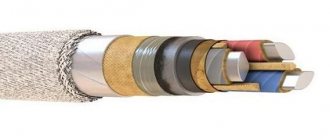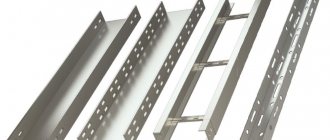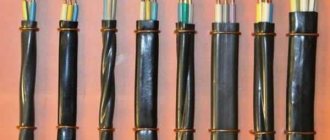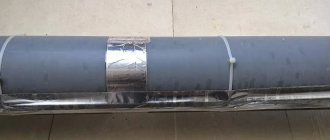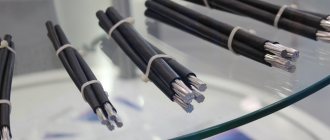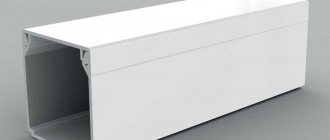KGtp-KhL is a flexible, cold-resistant power cable with copper conductors insulated and sheathed with thermoplastic elastomer. KGtp-KhL replaced its predecessor, the KG-KhL cable, as a result of a number of advantages and differences: 1) Ecology - the production of cables from thermoplastic elastomer (TEP) is more environmentally friendly than from rubber, and TPE is also easy to recycle, which is important considering short service life of flexible cables (4 years). 2) Resistance to external influences - TPE is more resistant to ultraviolet radiation, more easily withstands the chemical effects of solvents, oils and other active substances, and is more resistant to repeated bending, friction and shock. Example: shoe soles are made from thermoplastic elastomer, but at the moment only galoshes are made from classic rubber, and that is due to the production remaining from the times of the USSR. 3) Weight - TPE is lighter, which provides greater convenience during operation and transportation. 4) Temperature stability - TPE can retain its properties at temperatures from -60 to +150 (depending on the composition of the elastomer). From the above, it is obvious that TPE is significantly superior to rubber in all respects and is the next step in the production of general-purpose flexible cables.
Cable application area
This type of industrial multicore cable KGTP-HL is intended for use in industry, construction, transport and agriculture. Its area of application is temporary or permanent provision of power to various types of mobile industrial equipment, as well as intersection connections. The network parameters for using this cable must have a power rating of 0.6 kV/up to 400 Hz AC or 1 kV DC.
Design elements
CGTP are produced with the number of cores - from one to five.
Conductors consist of a large number of copper wires. According to GOST, class 5 flexibility is provided. The covering of each core is made of styrene-based thermoplastic elastomers and has an individual color.
In a stranded wire, insulated conductors are twisted together into a unidirectional twisted core of regular (symmetrical) cross-section. It is the correct twist section that provides increased flexibility.
The “twist” is covered with a black thermoplastic elastomer shell.
In a single-core cable, the copper core is covered with insulation and a sheath or immediately an insulating and protective sheath, again made of thermoplastic elastomer.
In multi-core CGTPs, the zero conductor is thinner than the phase conductors. For ease of cutting, the wires are treated with talc, which reduces the labor intensity of the work.
Decoding the KG marking
In this case, deciphering the abbreviation KG will tell little about the product itself. Indeed, “K” means cable, and “G” means the product belongs to the flexible class. Frankly speaking, there is not enough information. After all, all the wires of the power cable family, one way or another, bend. That is, they are flexible. One might assume that this brand belongs to the class of very flexible products, and this is true.
To finish with the decoding, we note that additional letters may be found in the markings. For example:
- KG-T, where “T” indicates that this brand is created for use in climatic zones with hot and humid (that is, tropical) climates;
- KG-HL – cable, for use in conditions where there are severe frosts;
- KG-N - indicates that the insulating shell does not propagate combustion. In addition, it is also oil resistant.
An example of KG brand wire is shown in Figure 1.
Figure 1. KG cable with rubber core insulation
Application
The main purpose of the KG cable brand is to connect portable electrical appliances to the electrical network. It can be used:
- in indoor areas;
- on platforms under a canopy;
- on the decks of ships;
- in different climatic zones, in all weather conditions.
Typically, the cable is laid on the ground or on the surface of an asphalt or concrete area. The wire is removed after completion of the work. The main condition is to avoid significant mechanical impacts on the outer shell.
The softness of the rubber, which makes the cable insulation invulnerable to bending, can cause its destruction due to mechanical stress. For example, being hit by a vehicle or a heavy object falling on a wire can damage it. Multi-core products are very sensitive to such influences, especially those that do not have an external gasket. The presence of an external gasket enhances the protective properties of the cable.
Rain water, puddles and dirt do not affect the performance of products with flexible rubber insulation. However, if you have to constantly work in conditions of high temperatures and high humidity (tropical climate), then it is better to use the KG-T brand. The outer sheath of such a cable is made of special rubber that is resistant to the development of mold, which destroys the insulation. Since tropical conditions are ideal for the development of various fungi and microorganisms, such insulation will last longer.
You can connect to the cable:
- mobile grain cleaning mechanisms;
- power tools;
- construction electrical equipment: concrete mixers, electric lifting devices, etc.;
- devices for connecting to ground and electrode holders for welding machines;
- portable power generators;
- other industrial and household mobile electrical appliances.
There are limitations in the use of KG brand electrical cables: the product cannot be used as permanent wiring. This is due to the fact that its insulation is very sensitive to mechanical stress. For the same reason, underground installation of CG is not allowed. The outer shell can even be damaged by soil pressure.
The exception is overhead wiring on overhead cables. An open cable line can also be installed on overpasses, taking all safety measures.
The mentioned restrictions on use also apply to analogues of the KG brand. Such products can be identified by their markings: CNG, KPGS, RPSh or KRPT. These conductors have characteristics similar in values to the types of cables we are considering. For example, a stranded wire RPSh has the same characteristics as a cable of the KG brand, but its flexibility is of a lower class. KG brand conductors can be replaced with analogues, taking into account the conditions of the climatic zones for which the product is intended.
Description and design of the KG cable
KG is a flexible power cable with copper conductors with insulation and a rubber sheath without protective covers (armor).
Explanation of the designation:
"K" - cable; "G" - flexible.
The most common KG cables are in the usual version with one, two or three main conductors and three main conductors and a grounding conductor (the so-called “three plus”).
To the designation of a KG cable in a tropical version, add the letter “T” through a hyphen (example: KG-T), for a cable in a cold-resistant version – add the letters “HL” through a hyphen (example: KG-HL).
The letter “n” is added to the designation of cables with a neutral conductor (example: KGn), the letter “v” is added to the designation of cables with one or two auxiliary conductors (without grounding and neutral conductors) (example: KGv).
Example of designation: KGn - KHL 2x25+ 1x16 - KG cable with a zero core in the “HL” version with two main cores with a cross-section of 25 mm2.
Since KG cables are intended for intensive operation in a wide temperature range, the technical specifications establish requirements for structural, electrical and mechanical parameters for both new cables and limit standards for cables during operation.
KG cables can have from one to five cores with a cross-section from 0.75 mm2 to 120 mm2.
The range of cross-sections of the main cores depending on the total number of cores is shown in the table.
| Number of cores | Nominal cross-section, mm 2 | ||
| Main | Neutral or ground | Auxiliary | |
| 1 | — | — | 2,5-120 |
| 2 and 3 | — | — | 0,75 – 120 |
| 2 and 3 | 1 | — | |
| 2 and 3 | — | — | 2,5 – 70 |
| 2 and 3 | — | 2 | 2,5 – 70 |
| 4 | — | — | 1,0 — 95 |
| 5 | — | — | 1,0 – 25 |
The cross-sections of neutral conductors, grounding and auxiliary conductors, depending on the cross-section of the main conductors up to 50 mm2, are given below. At the request of the consumer, other sections of the grounding conductor are allowed.
| Main veins | 0,75 | 1,0 | 1,5 | 2,5 | 4 | 6 | 10 | 16 | 25 | 35 | 50 |
| Zero core | 0,75 | 1,0 | 1,5 | 2,5 | 2,5 | 4 | 6 | 10 | 16 | 16 | 25 |
| Grounding conductor | 0,75 | 1,0 | 1,0 | 1,5 | 2,5 | 4 | 6 | 6 | 10 | 10 | 16 |
| Auxiliary core | — | — | 1,5 | 1,5 | 2,5 | 4 | 6 | 6 | 10 | 10 | 10 |
Current-carrying conductors must be twisted from individual copper wires (for tropical cables made of tinned) with a single wire diameter not exceeding that indicated in the table.
| Nominal conductor cross-section | 0,75 | 1,0 | 1,5 | 2,5 | 4 | 6 | 10 | 16 | 25 | 35 | 50 |
| Maximum single wire diameter | 0,21 | 0,21 | 0,26 | 0,26 | 0,31 | 0,31 | 0,41 | 0,41 | 0,416 | 0,41 | 0,41 |
The rubber insulation must be separated from the core without sticking, for which purpose a synthetic film can be laid between the core and the insulation.
The nominal and minimum values of the radial insulation thickness for cables with a cross-section of up to 50 mm2 are given in the table.
| Nominal cross-section, mm 2 | Nominal insulation thickness, mm | Minimum insulation thickness, mm |
| 0,75 – 1,5 | 0,8 | 0,62 |
| 2,5 | 0,9 | 0,71 |
| 4 and 6 | 1,0 | 0,8 |
| 10 and 16 | 1,2 | 0,98 |
| 25 and 35 | 1,4 | 1,16 |
| 50 | 1,6 | 1,34 |
The insulated conductors must have a distinctive color (the preferred one is shown in the table), while the insulation of the neutral conductors should be blue, and the insulation of the grounding conductors should be yellow-green (designation with the number “0” is allowed). The coloring must be continuous along the length; coloring in the form of a longitudinal stripe with a width of at least 2 mm is allowed.
| Number of cores | Preferred color scheme for core insulation | |
| With grounding conductor | With a neutral conductor and without a grounding conductor and a neutral conductor | |
| 3 | Yellow-green, blue, brown | Blue, black, brown |
| 4 | Yellow-green, blue, black brown | Blue, black, brown, black or brown |
| 5 | Yellow-green, blue, black brown, black or brown | Blue, black, brown, black or brown, black or brown |
Insulated conductors must be twisted, and twisting with an alternating change in direction is allowed for cables with a cross-section of the main conductors of 10 - 95 mm2.
It is allowed to twist cores with intercore filling in the form of bundles of rubber or synthetic threads.
The sheath must be applied in such a way that it can be easily separated from the core insulation. To do this, a synthetic film can be laid between the core insulation and the sheath. The shell color is predominantly black. In single-core cables, it is allowed to replace the insulation and sheath with an insulating protective sheath, applied in one layer with a thickness of at least twice the thickness of the insulation. The nominal and minimum values of the sheath thickness of the most common cable sections up to 50 mm2 are given in the table.
| Cable cross-section, mm2 | Nominal shell thickness, mm | Minimum shell thickness, mm |
| 1x10 | 1,8 | 1,43 |
| 1x16 | 1,9 | 1,52 |
| 1x25 | 2,0 | 1,6 |
| 1x35 | 2,2 | 1,77 |
| 2x1.5 | 1,5 | 1,18 |
| 2x2.5 | 1,7 | 1,35 |
| 2x4 | 1,8 | 1,43 |
| 3x1.5 | 1,6 | 1,26 |
| 3x2.5 | 1,8 | 1,43 |
| 3x4 | 1,9 | 1,52 |
| 3x1.5+1x1.5 (4x1.5) | 1,7 | 1,35 |
| 3x2.5+1x1.5 | 1,9 | 1,52 |
| 3x4+1x2.5 | 2,0 | 1,6 |
| 3x6+1x4 | 2,1 | 1,69 |
| 3x10+1x6 | 3,3 | 2,71 |
| 3x16+1x6 | 3,5 | 2,88 |
| 3x25+1x10 | 3,8 | 3,13 |
| 3x35+1x10 | 4,4 | 3,64 |
| 3x50+1x16 | 4,8 | 3,98 |
The difference between the maximum and minimum values of the outer diameter of the cable measured in one section (ovality) should not exceed 15% of the outer diameter.
Requirements for marking cable KG
Cables must be marked in the form of an inscription printed on the surface of the sheath or in the form of a tape under the cable sheath along the entire length or in the form of a distinctive thread. The inscription made on the surface of the sheath or tape must contain the trademark or name of the manufacturer and the year of manufacture of the cable. Cables in cold-resistant design must be additionally marked with the letters “ХЛ”. Marking in the form of an inscription can be made in relief or printed. The distance between inscriptions should not exceed 550 mm on the shell and 275 mm on the tape.
The drum cheek or label attached to the coil or drum must indicate:
— trademark or name of the manufacturer; — symbol of the cable (full indicating the number of cores and cross-section); — length of each cable section in meters; — gross weight in kilograms (determined approximately by calculation, based on the actual length and estimated weight); — date of manufacture (year, month); — drum or coil number. The label must bear a technical control stamp and a certification mark.
Available methods for quality control of KG cable
Control methods are presented that, although not strictly corresponding to the specifications, allow making preliminary conclusions about the quality of the cable if the measured values differ significantly from the regulated ones. The final conclusion about the compliance of the cable with the specifications can be made only after testing the cable in a specialized laboratory using strict methods and in the volumes specified in the technical specifications.
Visual inspection The following can be checked: the number and color of cores, the integrity of the insulation and sheathing and the ability to separate them without damage.
Measurement of structural dimensions Can be checked using suitable measuring instruments: thickness of insulation and sheath, diameter of wires in the core dpr. Calculating the cross-section of the core using the formula 0.785dpr2N (where N is the number of wires in the core) is not a strict method for controlling the cross-section of the cores, because confirmation of cross-section compliance is electrical resistance, however, a significant deviation of the calculated cross-section from the nominal (more than 15%) may serve as a basis for doubts about the quality.
Measurement of the electrical resistance of current-carrying conductors Can be carried out on a finished cable with an ohmmeter with a suitable measurement limit (for cables with a small cross-section at a normal length in a coil or on a drum, it can be several Ohms) and recalculated for a length of 1 km. If the cable has twisted cores, the obtained values should be reduced by 1.02 times. Particular attention should be paid to making good contact with the test leads.
KG cable load currents
The maximum permissible load currents at an ambient temperature of 25°C for cables with a cross-section of up to 50 mm2 are indicated in the table.
| Nominal cross-section, mm2 | Permissible load current, A | ||
| With one main residential | With two main cores | With three main cores | |
| 0,75 | — | 24 | 22 |
| 1,0 | — | 28 | 24 |
| 1,5 | — | 35 | 31 |
| 2,5 | 59 | 47 | 42 |
| 4 | 89 | 60 | 55 |
| 6 | 115 | 75 | 69 |
| 10 | 144 | 97 | 88 |
| 16 | 189 | 128 | 116 |
| 25 | 240 | 162 | 150 |
| 35 | 298 | 200 | 180 |
| 50 | 362 | 245 | 226 |
Weight and size parameters of cable KG
The approximate external dimensions and weights of individual cables with a cross-section of up to 50 mm2 for packaging and transportation purposes are given in the table. The given values may differ for cables of different batches and manufacturers by 10% less or more.
| Cable cross-section | External size value for packaging and transportation purposes, mm | Weight value for packaging and transportation purposes, kg/km |
| 1x10 | 11,1 | 230 |
| 1x16 | 12,4 | 310 |
| 1x25 | 14,6 | 450 |
| 1x35 | 16,4 | 590 |
| 2x1.5 | 9,4 | 130 |
| 2x2.5 | 11,2 | 190 |
| 2x4 | 13,5 | 280 |
| 3x1.5 | 10,1 | 160 |
| 3x2.5 | 12,0 | 230 |
| 3x4 | 14,5 | 350 |
| 3x1.5+1x1.5 (4x1.5) | 11,1 | 200 |
| 3x2.5+1x1.5 | 13,2 | 280 |
| 3x4+1x2.5 | 15,5 | 400 |
| 3x6+1x4 | 18,0 | 560 |
| 3x10+1x6 | 23,4 | 950 |
| 3x16+1x6 | 27,6 | 1300 |
| 3x25+1x10 | 33,1 | 1950 |
| 3x35+1x10 | 36,5 | 2400 |
| 3x50+1x16 | 42,4 | 3400 |
Purpose
The cables are designed for transmission and distribution of electrical energy in stationary and non-stationary electrical networks and installations for rated alternating voltage up to 1 kV with a nominal frequency of 50 Hz. It is prohibited to operate cables in a coiled state, as well as when exposed to directed physical and frictional loads. To connect moving machines and devices, trays and cable laying devices should be used that ensure compliance with the minimum permissible bend radii and the absence of abrasive wear. Installation and laying of KGTP-HL cables must be carried out in accordance with Appendix 3 of GOST 24334-80.
Specifications
The widespread use of CGTP is due to its technical characteristics. Manufacturers strictly comply with GOST 24334-80 (TU 3544-016-22901100-2015), so there are not many reasons to worry about product quality. The scope of cable use is manufacturing enterprises. They strictly adhere to safety requirements and once selling low-quality products can mean a loss of reputation and a decrease in subsequent sales.
The nominal cross-section of the main cores is up to 120 mm2.
The positive qualities of the products are:
- UV resistance, which allows the use of CGTP for open areas;
- resistance to temperature changes from +50 to -60 °C, and in the same range not only operation, but also installation is possible;
- maintaining operability at 98% air humidity (measured at +35 °C);
- heat resistance when working with increased loads - long-term operation is possible when the cores are heated to +75 ° C;
- flexibility class 5 (maximum possible class 6), allows bending in rotation of only 8 cable diameters;
- ease of installation - the construction length for the cable for models with a core cross-section of up to 35 mm2 is 150 m, for cores 50 - 120 mm2 - 125 m;
- tensile strength up to 19.6 N (2 kgf) for each mm2 of the total cross-section of all cores..
Face-to-face length is the length of the section on the drum upon delivery. In this way, the area can be equipped with one section without additional connection.
Where is it used and why?
Technical characteristics and increased resistance to climatic conditions and the ability to work in aggressive environments have determined the places where the products are used.
Cable CGTP:
- connect mobile devices and mechanisms to electrical networks, with a supply voltage of up to 660 V with a frequency of up to 400 Hz;
- provide connection to temporary objects, for example, construction sites;
- connect objects to generator installations in open areas;
- equip heavy engineering products, river and sea vessels;
- carry out electrical wiring, including power and signal, in mines and open workings;
- power handling equipment.
For cranes and winches, you cannot use a rubber-braided KG cable, which is similar to a KGTP cable.
The manufacturer has established a service life of 4 years, so it is not practical to use CGTP for equipment of stationary electrical networks.

